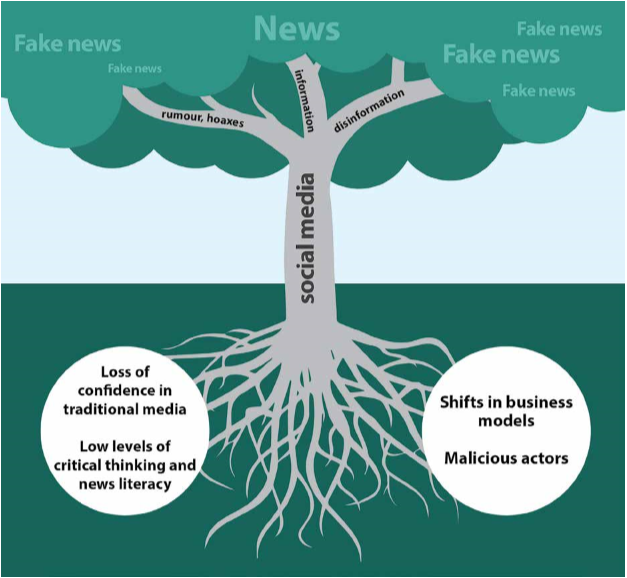 View Winners →
View Winners → Digital Technology and Social Media Has Given Humanity a Makeover


Disinformation takes many different forms. – Courtesy screenshot / CBS This Morning
By Terry Miller
Those of us so-called “boomers” probably remember the old Memorex ad “Blown Away,” “Is it live or is it Memorex?,” referring to the quality of their analog sound recording tape which is all but obsolete now — except for the purists among us who believe vinyl records and magnetic audio tape are more evocative than anything digital could reproduce.
The list goes on for what has essentially destroyed a perfectly happy and content analog life for most machines and many people.
Is it all about free speech and global freedom of expression as some say?
The digital world has created its very own form of a diablo-monster: replete with false narratives, misleading news articles intended to confuse as well as a plethora of adverts that attempt to sway not only your buying habits but your vote. This, of course, is part of the international discussion now with interference in the 2016 election.
It’s staggering how many people drink the Kool-Aid and get conned into a false sense of security with social media podiums like Facebook and Twitter.
According to a new report from the UK-based charity Article 19, freedom of expression has reached a 10-year low globally, as a result of what the report calls “digital authoritarianism” and threats against journalists. Governments in a number of countries have been increasing online surveillance and cracking down on content and behavior that indicates dissent, the report says. The survey notes that while there were some improvements in the overall freedom of expression environment around the world between 2008 and 2013, these gains were eroded in the five subsequent years. According to Article 19’s analysis, more than 65 countries with a combined population of over 5 billion people have seen their freedom of expression decline over the past decade.
Digital misinformation is everywhere and we’re inwardly digesting copious amounts of false info at breakneck speed: Here are some recent examples of internet insanity.
May 22, a Trump supporter named Shawn Brooks posted a video on Facebook called “Is Nancy Pelosi drunk?” The right wing video suggested that Pelosi, the Speaker of the House, was slurring her words and apparently drunk. Later that day, an additional video featuring Pelosi, was altered and slowed down to imply she was under the influence. The video appeared on at least two pro-Trump Facebook pages; later, it moved to Twitter and YouTube.
“In its first few hours online, the doctored video was viewed about three hundred times on Twitter. On Facebook, it was shared 18,881 times—which put it on the same scale as a recent video of a mysterious sea creature someone caught in Alaska. The American far right, fixated on the notion of strength, often attacks its enemies with the idea that they are weak or sick, and the Pelosi video seemed destined mostly to provide whoever happened to be browsing for hatred that day a temporary sense of affirmation. Were it not for subsequent developments, it would likely have slipped back into obscurity among posts targeting Bette Midler for her online activism and accusing Rep. Ilhan Omar of spreading Islamic law in America.” according to the Columbia Journalism Review.

The roots of “fake news,” UNESCO’s World Trends Report. – Courtesy photo / UNESCO (CC BY-SA 3.0 IGO)
It’s all about the clicks, apparently.
Every day scores of digital journalists seek the high that comes from posting first- regardless of the truth or fact checking. I guess it’s like seeing your byline for the first time in the paper as it rolls off the presses.
According to CJR, “The first major outlet to have published the Pelosi video appears to have been the Washington Post, which in February hired its first “competition analyst” to “monitor competitor sites and use digital and social analytics tools” to decide what to cover “right now” (the Post’s italics, in a press release).”
CJR continues, “The strange business of covering what people say on the Web has distinct stages. The first is: there is this thing on social media. That completed, newsrooms could now move on to the second: this famous person has said something about this thing on social media. Every publication and network you can think of—even those, like the New York Times, that publicly decry a cheapened information economy—joined in. A graph provided by Facebook shows views for the video spiking as a direct result. The number of daily shares rose from eighteen thousand to fifty thousand on Facebook alone. It is not recorded how many clicks the publications, most of which hosted their own versions of the video, collectively received. But it must be in the millions.”
In closing, we as a society have become hot-reactors to those who Tweet or post something on social podiums no matter which particular party you endorse. Those comments can turn vulgar and dangerous and sociologists have proved in recent research that this behavior has become highly addictive, and in fact anti-social.







































































































